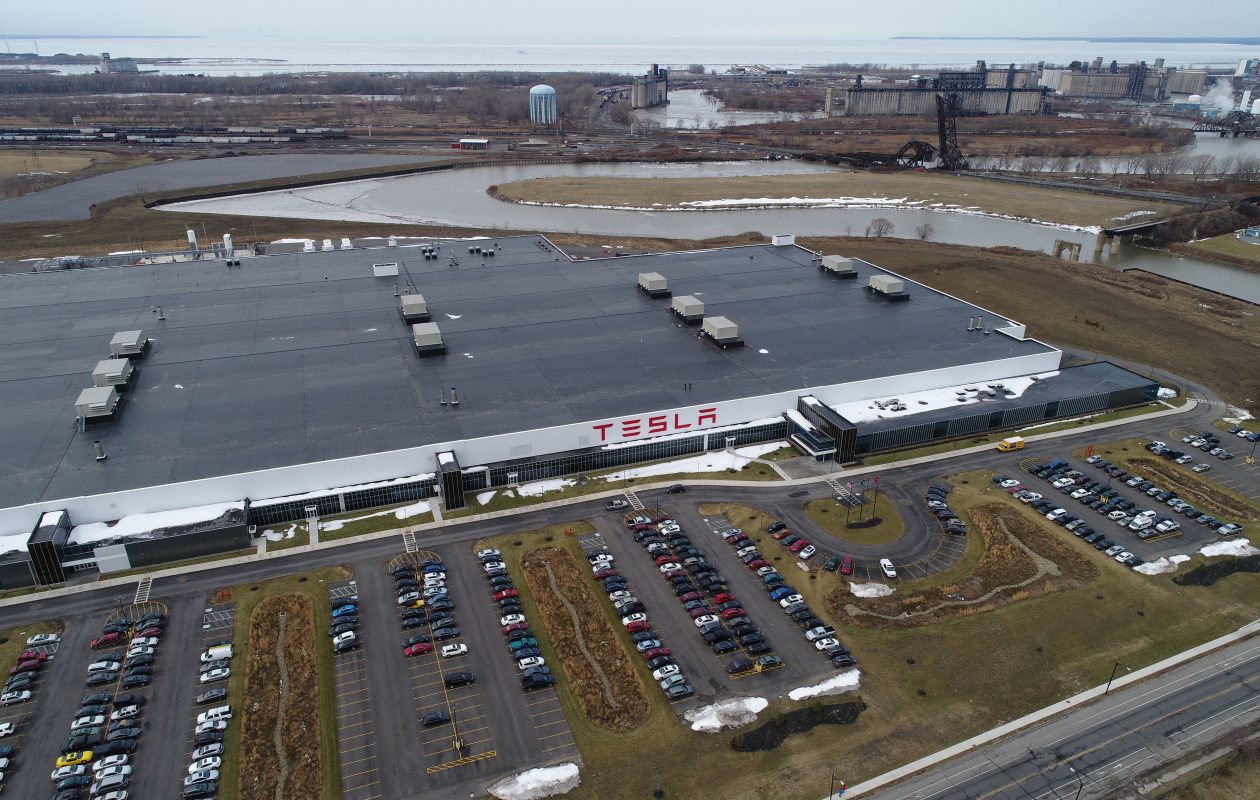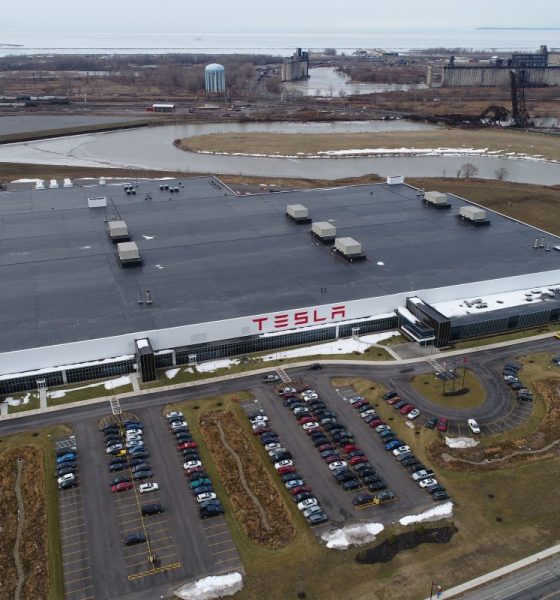

Energy
Tesla Giga New York to host “company talk” in April, customer and media tours available
Tesla will be holding a “company talk” in April from its Giga New York location where the company manufactures its Solarglass Roof tile and energy products from. Elon Musk took to Twitter on Monday to share initial details about the upcoming Gigafactory New York event, noting that there will also be factory tours for customers and the media.
News of Tesla’s April company talk comes on the heels of a series of tweets by Musk that revealed the ramping up of solar tile roof installations in the San Francisco Bay area and eventual plans to roll out Tesla solar products to Europe and China.
Tesla April company talk will be from our Giga New York factory, where we make SolarGlass & several other products. Will also offer customer & media tours.
— Elon Musk (@elonmusk) February 10, 2020
The month of April happens to be the same timeframe as Tesla “Battery Day” which Elon Musk mentioned during the recent earnings call.
“…we’re going to talk about this in Battery Day, which is probably April. And then a lot of these questions will be answered. I think it’s going to be a very compelling story that we have to present. I think it’s going to actually blow people’s minds. It blows my mind, and I know it. So it’s going to be pretty cool,” Musk said.
Tesla produces it’s solar roof tiles, branded as Solarglass Roof, at the Buffalo, New York factory. The Solarglass looks like a contemporary roof tile but with nearly indestructible properties and acts “alive” by generating power through the sun. Tesla’s third-generation Solar Glass roof tile is simpler and faster to install than previous iterations. The company has a goal to manufacture approximately 1000 solar roofs per week, and will focus customer installations on California before expanding to the rest of the United States and eventually to overseas markets.
I was pleasantly surprised by my recent visit to the Tesla plant. It was encouraging to see Solar roofs, batteries, and charging stations being built in the facility. Tesla reports over 1100 workers at the plant and they say they will hit 1460 by the April deadline. pic.twitter.com/33aSuRdQLC
— Senator Sean Ryan (@SenSeanRyan) February 8, 2020
A recent interview with New York Assembly member Sean Ryan with WBEN hinted that Tesla has also been producing batteries at Giga New York aside from its solar roofs and charging stations. Tesla has been tight-lipped about the production in the Buffalo facility but Ryan was pleased when he toured the factory last Friday.
“The factory is built out. It has complete lines running, product moving around, people are there, so it’s really transformed itself into what we’ve been hoping for. We’ve been holding our breath since we put that big bet down on Tesla. They had a slow start, and I was worried as we’re approaching this spring they were going to hit their deadlines, but they’re right on track,” he said.
Tesla has also reportedly been hiring hundreds of employees for its Buffalo facility in a bid to ramp up production at Giga New York and increase focus on its solar business. The company deployed 54 MW in the last quarter of 2019 or about a 25 percent jump from Q3’s 43 MW deployment. Tesla is looking to deploy at least 260 MW of solar energy systems this year, or a 50 percent increase over the 173 MW systems deployed in 2019.

Cybertruck
Tesla updates Cybertruck owners about key Powershare feature

Tesla is updating Cybertruck owners on its timeline of a massive feature that has yet to ship: Powershare with Powerwall.
Powershare is a bidirectional charging feature exclusive to Cybertruck, which allows the vehicle’s battery to act as a portable power source for homes, appliances, tools, other EVs, and more. It was announced in late 2023 as part of Tesla’s push into vehicle-to-everything energy sharing, and acting as a giant portable charger is the main advantage, as it can provide backup power during outages.
Cybertruck’s Powershare system supports both vehicle-to-load (V2L) and vehicle-to-home (V2H), making it flexible and well-rounded for a variety of applications.
However, even though the feature was promised with Cybertruck, it has yet to be shipped to vehicles. Tesla communicated with owners through email recently regarding Powershare with Powerwall, which essentially has the pickup act as an extended battery.
Powerwall discharge would be prioritized before tapping into the truck’s larger pack.
However, Tesla is still working on getting the feature out to owners, an email said:
“We’re writing to let you know that the Powershare with Powerwall feature is still in development and is now scheduled for release in mid-2026.
This new release date gives us additional time to design and test this feature, ensuring its ability to communicate and optimize energy sharing between your vehicle and many configurations and generations of Powerwall. We are also using this time to develop additional Powershare features that will help us continue to accelerate the world’s transition to sustainable energy.”
Owners have expressed some real disappointment in Tesla’s continuous delays in releasing the feature, as it was expected to be released by late 2024, but now has been pushed back several times to mid-2026, according to the email.
Foundation Series Cybertruck buyers paid extra, expecting the feature to be rolled out with their vehicle upon pickup.
Cybertruck’s Lead Engineer, Wes Morrill, even commented on the holdup:
As a Cybertruck owner who also has Powerwall, I empathize with the disappointed comments.
To their credit, the team has delivered powershare functionality to Cybertruck customers who otherwise have no backup with development of the powershare gateway. As well as those with solar…
— Wes (@wmorrill3) December 12, 2025
He said that “it turned out to be much harder than anticipated to make powershare work seamlessly with existing Powerwalls through existing wall connectors. Two grid-forming devices need to negotiate who will form and who will follow, depending on the state of charge of each, and they need to do this without a network and through multiple generations of hardware, and test and validate this process through rigorous certifications to ensure grid safety.”
It’s nice to see the transparency, but it is justified for some Cybertruck owners to feel like they’ve been bait-and-switched.
Energy
Tesla starts hiring efforts for Texas Megafactory
Tesla’s Brookshire site is expected to produce 10,000 Megapacks annually, equal to 40 gigawatt hours of energy storage.

Tesla has officially begun hiring for its new $200 million Megafactory in Brookshire, Texas, a manufacturing hub expected to employ 1,500 people by 2028. The facility, which will build Tesla’s grid-scale Megapack batteries, is part of the company’s growing energy storage footprint.
Tesla’s hiring efforts for the Texas Megafactory are hinted at by the job openings currently active on the company’s Careers website.
Tesla’s Texas Megafactory
Tesla’s Brookshire site is expected to produce 10,000 Megapacks annually, equal to 40 gigawatt hours of energy storage, similar to the Lathrop Megafactory in California. Tesla’s Careers website currently lists over 30 job openings for the site, from engineers, welders, and project managers. Each of the openings is listed for Brookshire, Texas.
The company has leased two buildings in Empire West Business Park, with over $194 million in combined property and equipment investment. Tesla’s agreement with Waller County includes a 60% property tax abatement, contingent on meeting employment benchmarks: 375 jobs by 2026, 750 by 2027, and 1,500 by 2028, as noted in a report from the Houston Business Journal. Tesla is required to employ at least 1,500 workers in the facility through the rest of the 10-year abatement period.
Tesla’s clean energy boom
City officials have stated that Tesla’s arrival marks a turning point for the Texas city, as it highlights a shift from logistics to advanced clean energy manufacturing. Ramiro Bautista from Brookshire’s economic development office, highlighted this in a comment to the Journal.
“(Tesla) has great-paying jobs. Not just that, but the advanced manufacturing (and) clean energy is coming to the area,” he said. “So it’s not just your normal logistics manufacturing. This is advanced manufacturing coming to this area, and this brings a different type of job and investment into the local economy.”
Energy
Tesla and Samsung SDI in talks over new US battery storage deal: report
The update was related by industry sources and initially reported by South Korean news outlets.

Recent reports have suggested that Tesla and Samsung SDI are in talks over a potential partnership to supply batteries for large-scale energy storage systems (ESS).
The update was related by industry sources and initially reported by South Korean news outlets.
ESS batteries to be built at Samsung’s Indiana plant
As noted in a report from Korea JoongAng Daily, the demand for energy storage systems has been growing rapidly in North America, thanks in no small part to the surge in AI investments across numerous companies. With this in mind, Tesla has reportedly approached Samsung SDI about a potential battery supply deal.
The deal is reportedly worth over 3 trillion Korean won (approximately $2.11 billion) and will span three years, according to The Korea Global Economic Daily. A battery supply deal with Samsung SDI could make sense for Tesla as the company already has a grid-scale battery, the Megapack, which is perfect for industrial use. Samsung SDI could simply supply cells for the EV maker.
Production of the batteries would reportedly take place at Samsung SDI’s joint venture factory with Stellantis in Indiana, which is currently under construction. Samsung SDI recently announced plans to use part of that plant’s EV lines to produce cells for ESS, with a targeted capacity of 30 GWh by the end of next year.
Tesla and Samsung’s partnership
At present, only a handful of manufacturers, including Korea’s LG Energy Solution, Samsung SDI, SK On, and Japan’s Panasonic, are capable of producing energy storage-scale batteries domestically in the United States. A Samsung SDI official issued a comment about the matter, stating, “Nothing has been finalized regarding cooperation with Tesla.”
The possible energy storage system deal adds another layer to Tesla’s growing collaboration with Samsung, which is already in line as a partner in the upcoming production of Tesla’s AI5 and AI6 chips. Early sample manufacturing of the AI6 is expected to begin in South Korea, with mass production slated for Samsung’s Texas-based Taylor foundry when it starts operations.
The AI6 chip will power Tesla’s next wave of high-volume projects, including the Optimus humanoid robot and the autonomous Cybercab service. Musk has called the partnership with Samsung a “real collaboration,” adding that he personally plans to “walk the line” at the Taylor facility to speed up progress.








